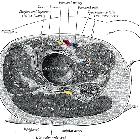Linea aspera

The linea aspera is a longitudinally-oriented ridge on the posterior aspect of the femur to which several muscles of the thigh attach. It is comprised of medial and lateral lips which diverge at both its superior and inferior ends.
Gross anatomy
Attachments
- lateral and medial intermuscular septa
- adductor muscles
- pectineus
- adductor minimus
- adductor brevis
- adductor longus
- adductor magnus (hamstrings part)
- biceps femoris (short head)
- vastus lateralis and medialis
Relations
Superior continuation
Superiorly, the medial lip is continuous with the spiral line and the lateral lip is continuous with the gluteal tuberosity. The central aspect of the linea aspera, between the medial and lateral lips, is continuous with the pectineal line superiorly.
Inferior continuation
Inferiorly, the medial and lateral lips continue as the medial and lateral supracondylar lines respectively. The medial and lateral supracondylar lines form the lateral margins of the popliteal fossa.
Variant anatomy
There are four major anatomical variants based on the distance between the medial and lateral lips throughout the length of the linea aspera :
- type 1 (parallel): equal distance between the medial and lateral lips throughout
- type 2 (concave): widest distance between the medial and lateral lips at the proximal and distal ends, narrowest distance in the middle
- type 3 (convex): widest distance between the medial and lateral lips in the middle, narrowest distance at the proximal and distal ends
- type 4 (variform): distance between the medial and lateral lips variable throughout (most common type)
Radiographic features
Plain radiograph
On anteroposterior projections of the femur in adults and rarely, in adolescents, the linea aspera may appear as two axially-oriented, parallel lines in the middle of the femoral shaft. This appearance, termed the track sign, is a normal variant that is important to distinguish from the blade of grass sign in Paget disease .
On lateral projections, prominence of the linea aspera may cause scalloping of the posterior femoral margin; this can mimic the radiographic appearance of osteonecrosis and periosteal reaction .
Development
The linea aspera is absent in childhood, appearing around the time of puberty and increasing in prominence through adulthood .
History and etymology
In Latin, linea means "line" and aspera means "rough" .
Siehe auch:

 Assoziationen und Differentialdiagnosen zu Linea aspera:
Assoziationen und Differentialdiagnosen zu Linea aspera:


